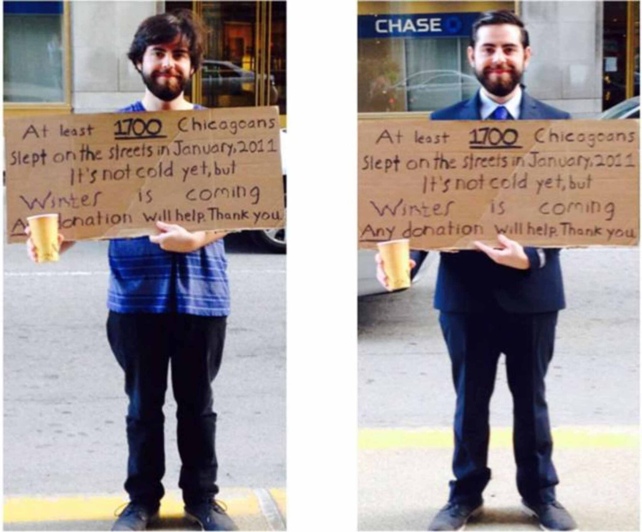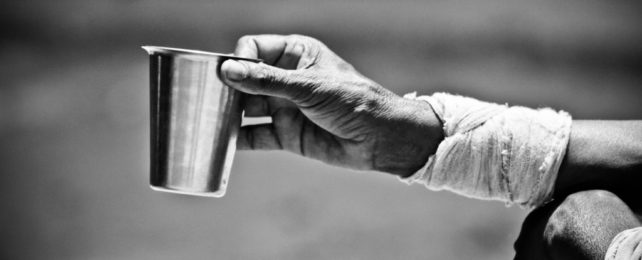A new social experiment on the busy streets of New York and Chicago uncovered an unfortunate paradox for those experiencing homelessness.
In the real-world study, pedestrians were more likely to donate money to the unhoused when the person holding a donation cup was wearing a business suit.
If the person asking for money was simply wearing a t-shirt and jeans, people passing by donated less money less often – half as much in total.
Even when unofficially giving to charity – which the researchers describe as "an ostensibly selfless behavior" – they argue that pedestrians might unknowingly perpetuate economic inequality, donating to those with more as opposed to less.

"As economic inequality rises in many parts of the world, and countries such as the United States roll back social safety net programs, the responsibility for dealing with inequality's deleterious impacts has increasingly fallen to economically precarious individuals themselves or to private citizens exercising compassion," writes the team, led by first author and social psychologist Bennett Callaghan from the City University of New York.
Given that extreme shift in responsibility, researchers are trying to figure out ways to improve charitable giving.
A major limitation of the experiment was that the person who stood on the street and asked for money (the first author of the study) did not claim that he was personally experiencing homelessness so as not to mislead any charitable passers-by.
Instead, he held a sign that read, "At least 1,700 Chicagoans slept on the streets in January 2011. It's not cold yet, but winter is coming. Any donation will help. Thank you." A different sign applied to New York.
If anyone stopped and asked him what he was doing, he would tell them he was collecting money for charity (the funds were ultimately donated at the end of the study).
The only variables were whether the charity collector was asking for money in Chicago or New York, and whether he was dressed in a business suit, with slicked-back hair, or jeans and a t-shirt, with unruly hair.
The findings suggest pedestrians on busy city streets judge the social class of those asking for money based on appearance only and give accordingly.
Past studies have shown our perceptions of social class can influence how we see strangers. Signs of poverty can actually elicit lower levels of warmth and empathy towards others, further contributing to alienation and dehumanization.
Some experiments in the 1970s found those with higher status often receive more aid, financial or otherwise, than those with lower status.
"Thus," the authors of the current study write, "the ability to perceive social class in others not only allows humans to identify social hierarchies – and their own place within them – but it also allows for patterns of social perception that implicitly justify these hierarchies, portraying those at the bottom as incompetent or undeserving."
The current experiments in New York and Chicago can't tell us what pedestrians were thinking if they dropped money in the cup, but they do suggest that rapid assessments of social status are somehow at play.
When the study's first author was dressed in a business suit, he drew more donations in both number and quantity over several hours.
Together, his upper-class attire was two times as effective as a pair of jeans and a t-shirt.
In 3.5 hours, the charity collector received just over US$54 in a business suit. Over four hours, he collected just over US$21 in a t-shirt.
An online survey followed up these results by asking 486 participants to look at images of the previous experiment and report their perception of the charity collector.
Both the suit attire and the t-shirt attire were judged as lower in status, but the latter outfit more so. When the charity collector dressed in a t-shirt, survey participants rated him comparatively lower on warmth, competence, humanity, and relatability.
Perhaps, the authors elaborate, this is why pedestrians gave the charity collector less money when he was dressed in a t-shirt. Maybe in this outfit, the man was seen as less 'deserving', trustworthy, or approachable.
But these are just possibilities; pedestrians who gave money were not surveyed.
The authors also acknowledge that street goers may have thought the charity collector was actually collecting for charity. This might explain why they gave more to the professionally dressed person.
That said, the team thinks this perception is unlikely. The cardboard sign isn't indicative of a professional institution, which means most people would probably assume the collector was taking the money for himself.
Very few people actually interacted with the man, even those dropping money in his cup, regardless of how he was dressed.
The study was published in Frontiers in Psychology.
